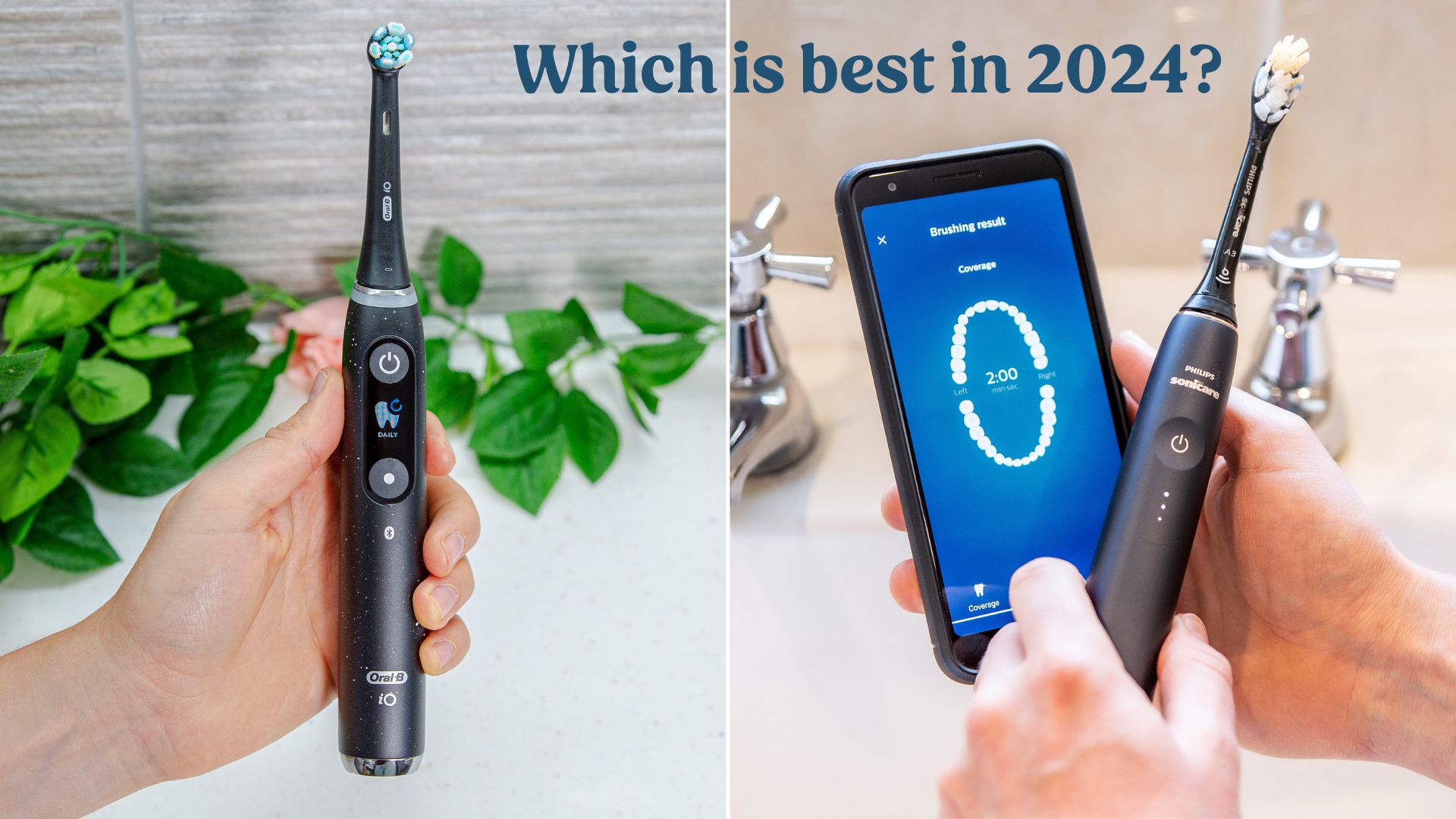
Our verdict
Having thoroughly tested both of the ranges, I recommend Oral-B electric toothbrushes, specifically the Oral-B Smart 2000, as the best value and overall top choice.
Sonicare brushes are comparable in performance and features, but Oral-B models like the Smart 2000 tend to be more affordable while still offering the key brushing capabilities that impact dental health.
In particular, Oral-B brushes use oscillating-rotating technology that closely mimics the motion of a manual toothbrush and provides a deep clean. And the Smart 2000 has multiple cleaning modes and a built-in timer to ensure proper brushing technique. It is my choice for the best electric toothbrush.
The Oral-B Smart 2000 is our main recommendation

Sonicare brushes use high frequency vibrations for cleaning, which some prefer, but the performance is similar. Ultimately Oral-B takes the edge for its balance of proven cleaning technology, important features, and reasonable prices.
The Sonicare equivalent to the Smart 2000 is the 4100 Series. It does compete well and is a good alternative, but for superior value, Oral-B is the winner.
Regardless of which brand you choose, the most important thing is to ensure you use the correct brushing technique.
The Sonicare 4100 Series is also a good choice

Sonicare vs Oral-B: the short answers
I know you might be short of time and want quick answers, so I've included them in the table below.
If you click on one of the questions it will jump you to a more detailed explanation later in the article.
| Which has the best brushing technology? | Oral-B |
| Which has the best design? | Sonicare |
| Which offers the most features? | Sonicare |
| Which is quietest? | Sonicare |
| Which has the most accessories? | Oral-B |
| Which has the best battery life? | Sonicare |
| Which is the most innovative? | Sonicare |
| Which is the best quality? | Sonicare |
| Which is the cheapest? | Oral-B |
| Which is best for families? | Oral-B |
| Which is best for travel? | Sonicare |
| Which has the best warranty? | Oral-B |
And the long answers
In the following sections I look more closely at the headline answers I've given above. For some of the categories it is not quite as simple as selecting just one brand that is better, so I explain the nuances in more detail below.
Which has the best brushing technology?
In my short answers, I said Oral-B.
Evidence shows Oral-B to remove more plaque. Although in reality this may not be as important as it seems.
Both Oral-B and Sonicare use slightly different technology and engineering to do the same job.
It’s a bit like having a gas or electric heating in your home. Both can heat your home but they do so in slightly different ways.
Both are better than using manual toothbrushes. Pitchika et al published the results of an 11 year study in 2019. They proved that powered toothbrushes were effective in reducing the probing depth for people with gum disease. This is the distance between the top of the gum and the tooth - a smaller gap indicates better gum health. They also found that people using electric toothbrushes retained more teeth.
Back to which has the better technology.
Philips uses Sonic technology whilst Oral-B uses an Oscillating-Rotating approach.
This animated gif shows how the sonic and oscillating-rotating motions differ.
We also have separate buying guides on Oral-B brush heads and Sonicare brush heads that explain the difference between the brushes.
Sonicare technology has two methods to clean the teeth. There is a mechanical method and also a non-contact method.
The mechanical cleaning uses physical contact between the bristles and the tooth surface. The motor causes the head to vibrate. This vibration causes the bristles to move side-to-side and remove plaque by scrubbing the surfaces. This is similar to a manual brush except the motor moves the head, not you.
To be called a sonic toothbrush this vibration must be at a speed that causes and audible hum. This is up to about 20,000 Hz (or vibrations per second). Vibrations faster than this are "ultrasonic" and can not be heard by the human ear.
The second method is a non-contact approach. The vibrations or sound waves themselves disrupt plaque beyond the tips of the bristles, without the bristles actually touching that area.
The exact way that this happens is not fully understood, but it is thought that very high frequencies cause liquids to move and create "hydrodynamic forces" which damage the plaque layer in hard to reach areas (1). This intense vibration agitates fluids that surround the teeth and can loosen and remove dental plaque in locations that are beyond the physical touch of the toothbrush. To have this effect the waves actually need to be working at a much higher speed, in the ultrasonic range, greater than 20,000 Hz.
The ultrasonic (non-contact) method of cleaning is good, but not effective enough by itself. This is which Sonicare (and similar toothbrushes) work at a range of vibrations that also includes speed which physically remove debris. Because you can hear the vibrations, these brushes are called sonic brushes. Purely ultrasonic brushes should not be used on a day to day basis because they do not remove all the plaque.
Many brushes in the Sonicare range offer up to 31,000 brush strokes/62,000 movements per minute. The exact number of movements depends on the cleaning mode and intensity selected. Not all brushes have different cleaning modes or intensity choices.
The brush head on a sonic brush is a lot like a manual toothbrush in its size and shape. It covers several teeth at the same time, and is oval shaped.
Oral-B’s cleaning is completed via an Oscillating-Rotating series of movements.
Oral-B brushes have a small, round brush head that moves in a circular motion to help remove plaque and dental debris.

When using an oscillating-rotating toothbrush, you should gently move the brush head from tooth to tooth, letting the brush do the cleaning. The movement of the bristles and the head itself essentially scrub the teeth clean. You don’t need to repeatedly move the bush up and down, back and forth.
Oral-B brushes have a small, round brush heads. These heads turn 45 degrees to the right and then 45 degrees to the left. This is a rotation movement. In addition to rotating in a circular motion, they also oscillate back and forth.
This oscillating-rotating movement is referred to as '2D' cleaning by the brand.
Add in Pulsations (essentially vibrations) and this now becomes '3D' cleaning. This pulsations is a movemen back and forth - i.e. towards the tooth surface and away again.
Pulsations offer a more sophisticated motion and give another dimension to the brushing.
Whereas the 2D cleaning requires the physical movement of the brush head against the teeth, pulsations are essentially a 'non contact' form of brushing and relies on pulsations/vibrations like Sonicare brushes do.
Overall, research does support the Oral B technology as being better at removing plaque than the Sonicare technology. There are individual studies in favour of each respective company. Both are better than using a manual toothbrush.
Clinical studies such as this one suggest a marked difference in the clean offered by the oscillating rotating brush compared to the sonic option.
That study was published by Procter & Gamble, the parent company of Oral-B.
In 2014, Klukowaska et al again concluded that the oscillating rotating brush from Oral-B outperforming Sonicare. They reported
"The oscillating-rotating brush with the novel brush head demonstrated statistically significantly greater reductions in all gingivitis and plaque measures compared to the sonic toothbrush. The benefits for the oscillating-rotating brush over the sonic brush were 32.6% for gingivitis, 35.4% for gingival bleeding, 32% for number of bleeding sites, 22% for whole mouth plaque, 24.2% for gingival margin plaque, and 33.3% for approximal plaque".
Other research, such as that by Strate et al also agrees. They conclude "Based on the findings of this single-use clinical evaluation, the action of the oscillating/ pulsating power toothbrush is more effective at plaque removal than a high frequency power toothbrush.".
On the other hand a 2019 study in the Journal of Clinical Dentistry (page A9) funded by Philips Oral Healthcare shows their sonic toothbrush to outperform the oscillating-rotating of Oral-B.
This is backed up by a 6 month study by Robinson et al that concluded: "Sonicare brush is superior to the Braun brush in reducing gingival inflammation and probing depth".
There are plenty of other individual studies in either direction.
Part of the problem is that studies require a large amount of funding. Inevitably, it is the larger organisations who can make the monies available, hence much of the data comes from research financed by the likes of Oral-B and Sonicare.
There is independent research available. These come in the forms of reviews of all available papers, and are considered a better quality of evidence than individual studies.
One such independent study was completed by Cochrane in 2020 and they report that there is some evidence that oscillating technology used by Oral-B is more effective.
Two other 2021 research reviews - by Thomassen et al and El-Chami et al also agree- the oscillating-rotating technology removes more plaque than the sonic technology.
Whilst the evidence is that there is a fairly certain small benefit, whether this will make much difference in the mouth is unclear. This is because results from tests in the lab do not automatically translate to real world scenarios.
For example, you also have to consider your technique - how you brush with an electric toothbrush. Both types of toothbrush need a different technique to manual toothbrushes.
But the technique is different for the different technologies too. The correct way to use an Oral-B toothbrush is different to a Sonicare. So, whilst the studies may suggest Oral-B is better, if someone used a Sonicare with the correct technique, compared to an Oral-B user with the incorrect technique, the Sonicare would likely perform better for that user.
The way the cleaning is done will have different sensations in the mouth. This will influence your decision on the best brush for you.
Having used many different models and different cleaning modes from both brands, Oral-B’s clean can feel more abrasive/aggressive. You are left with a ‘clean’ feeling, this can be at the expense of a slightly more uncomfortable clean for some people. Sonicare models feel softer and more delicate whilst still leaing your mouth feeling clean and fresh.
This is clearly personal preference. Some people will want to feel the clean, whilst others may find it overbearing.
Whilst perhaps Oral-B has the edge the good news is that both are beneficial.
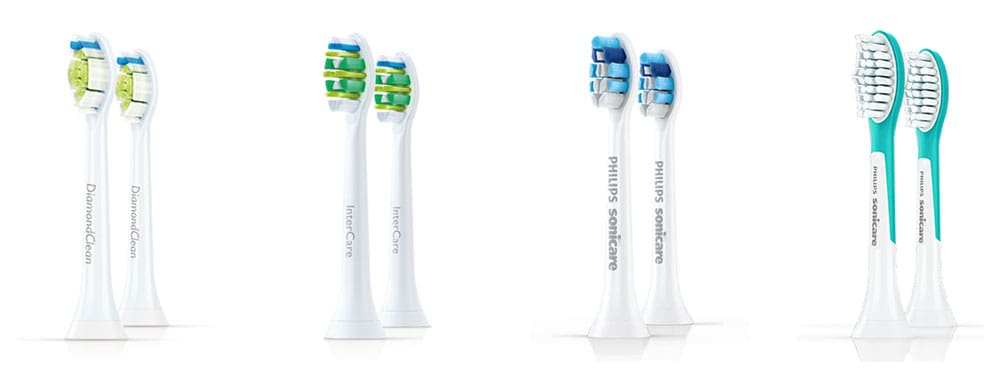
Which has the best design?
In my short answers, I said Sonicare.
So this is perhaps one of the most personally influenced categories on which to judge a toothbrush.
Generally speaking, Sonicare brushes have a more clinical look and feel to them. Many of them are a matte white with very mild/soft color accents on the power buttons and occasionally a rubber grip.
The most premium range, the DiamondClean series is much more focused on the design and whilst there is a white option there is a cashmere grey, pink and black too.
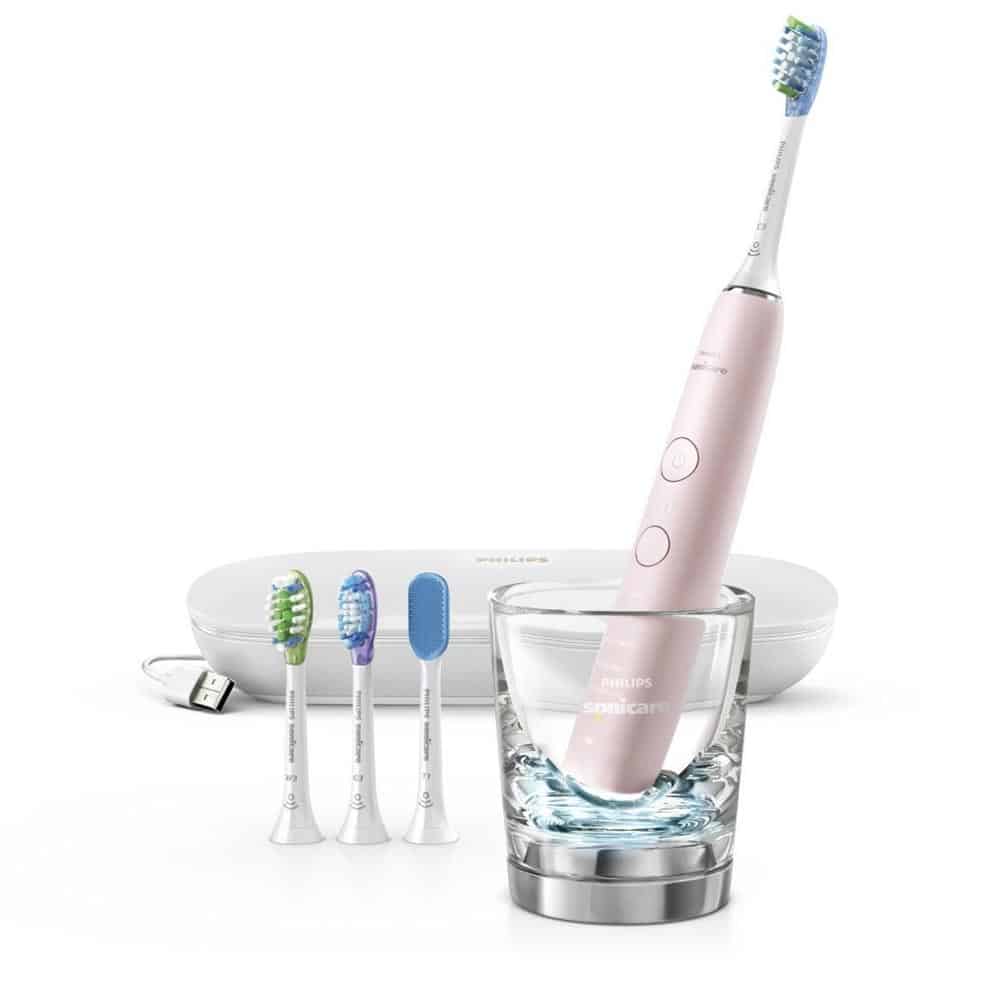
Oral-B brushes often have a gloss white plastic body that is accented by a large rubber grip that runs down the front handle. The color of the grip depends on the model. From black to pink to blue to green. With some models, you generally do not have much choice, but Oral-B have been improving the color options available, particularly at the higher end of their range. The Genius models are often available in various colors.
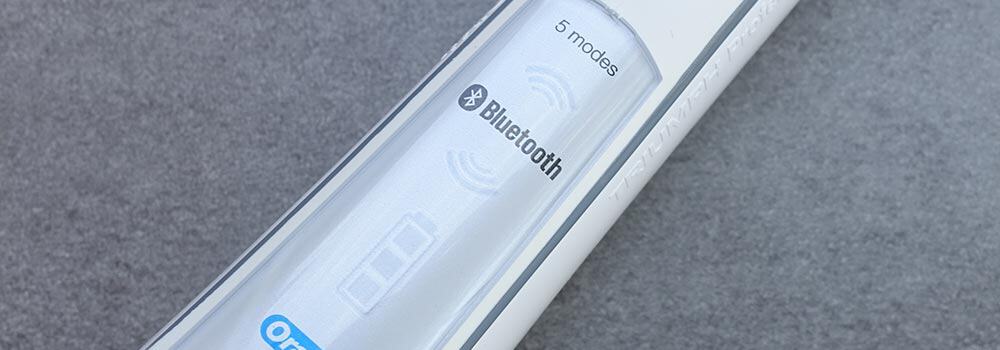
Which offers the most features?
In my short answers, I said Sonicare.
In recent years, Oral-B was the winner here, but since Sonicare have introduced BrushSync, I feel they now have more features available on some of their brush handles. What you might class as a feature may differ, to me.
Despite claiming Sonicare win this category, Oral-B tends to offer more features on cheaper brush handles. Particularly in the mid range brushes, you generally get a pressure sensor and Bluetooth connectivity on models that are cheaper than Sonicare.
Most Sonicare brushes have 1-2 cleaning modes unless you go up to the most premium model which offers 3-5; whereas Oral-B has 1-4 modes until the most premium models that offer 5-6 modes.
A pressure sensor is something that you didn't see all that often on Sonicare brushes, but newer brush handles come with it as standard. Although at present, the implementation is not quite as good as Oral-B. With Oral-B, it is a light on the back of the brush handle that illuminates when the brush detects you are brushing too hard. It is a simple and easy way to become aware of the issue that is brushing too hard. Sonicare have a vibration alert, whilst functional is less obvious.
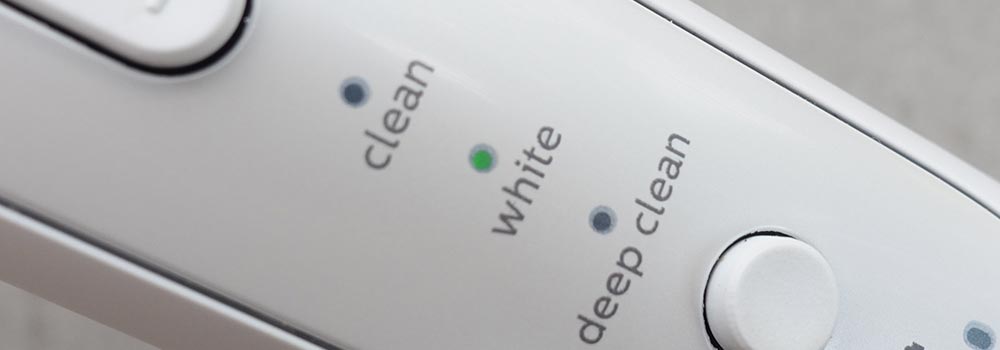
A newer feature (although it has been around for a few years now) is Bluetooth connectivity which shares brushing data with your phone. Sonicare have 2-3 models that can do this whereas Oral-B have 8.
Sonicare offers an Easy-Start mode which increases the power of the brush over the first 14 cleans, easing in a new user.
They do also offer an automatic power off feature which in my opinion is the best feature and most applicable of all additions over the basic cleaning mode.
What propels Sonicare forward is BrushSync, which is a 2 part system that alerts you when it is time to change your brush head and selects the most suitable cleaning mode, based on the brush head fitted to the handle.
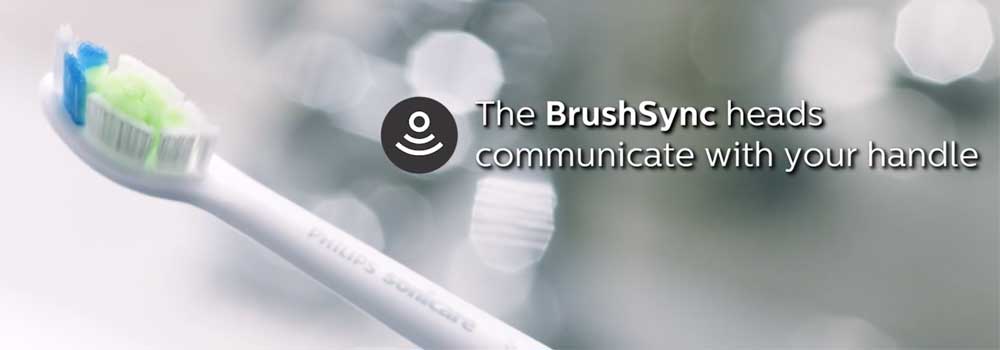
Whilst all these features are great, there is one thing that many of us, myself included forget or overlook and that is how we use them. It is all very well having 6 cleaning modes, but what is the point if we only use them once or twice. Most of us fall into the trap of just using the standard ‘Clean’ mode most of the time. We either forget about the others or simply don’t bother.
The pressure sensor is great, but after about 2 weeks, you know how hard or soft to brush.
Sonicare’s easy start mode, brilliant. Not really worthwhile after those first 14 cleans….
Box contents could also be considered here, however, I have given this its own category.
Which is quietest?
In my short answers, I said Sonicare.
There is no contest here, Sonicare brushes as a whole are much quieter.
Sonicare produce a strong vibration and humming sound, whereas the Oral-B brushes produce a much louder mechanical noise. It is hard to explain the difference.
The best thing to do is to watch the following video.
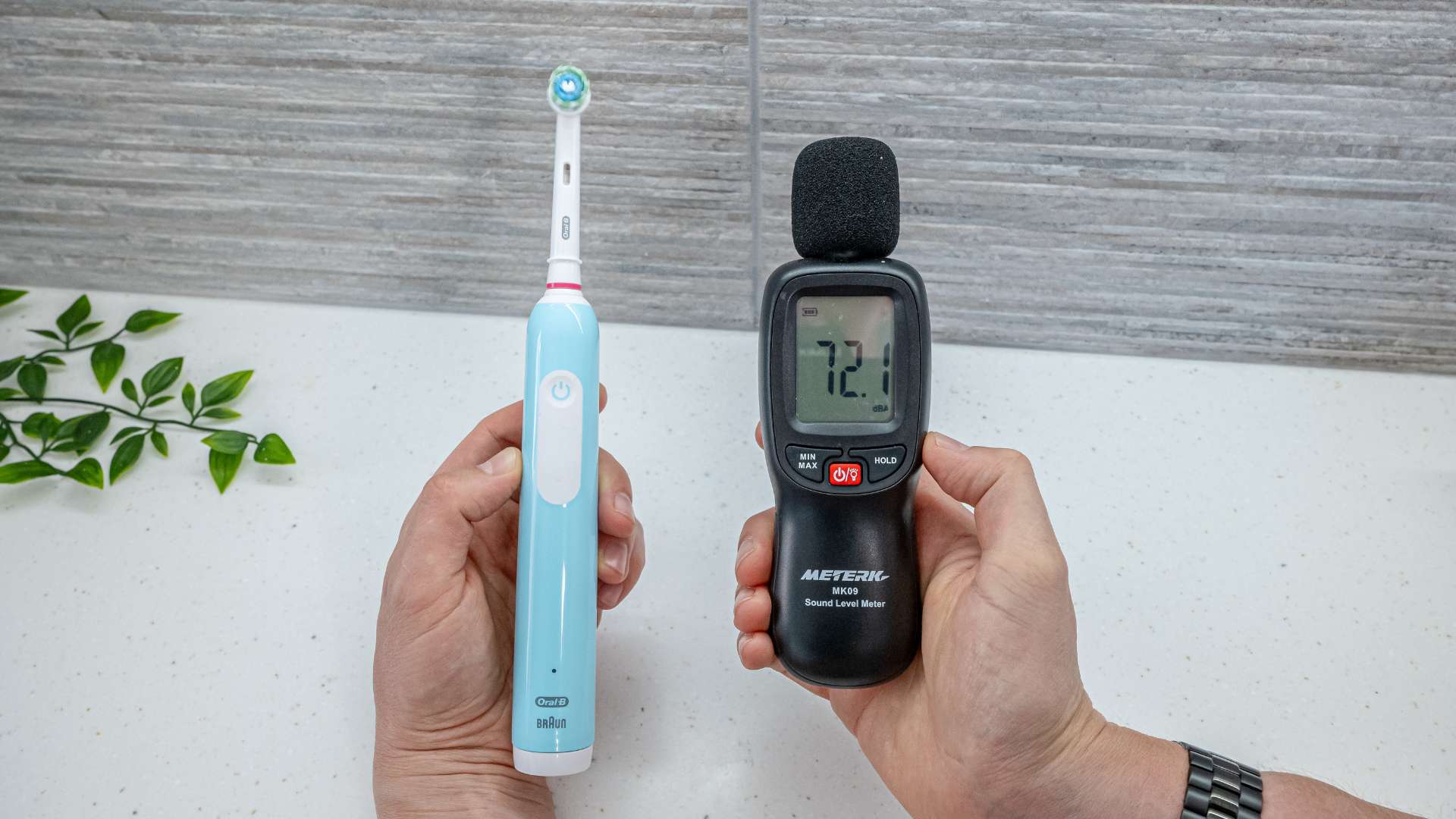
For a more detailed scenario, imagine cleaning your teeth in the bathroom of a house in the middle of the night when everyone else is asleep. With an Oral-B brush unless you closed the bathroom door you would likely wake someone up. With Sonicare you could leave the bathroom door open and probably nobody would hear you.
Some Sonicare models get close to the sound levels of the Oral-B brushes but this is usually on specific deep clean/power intensive modes.
Oral-B's iO range is quieter than most other Oral-B models, but it is still on average about 10 decibels louder than Sonicare.
If the noise of the brush is particularly important to you, take a look at our article, what's the quietest electric toothbrush which includes decibel readings to show how loud or quiet popular brush models are.
Which has the most accessories?
In my short answers, I said Oral-B.
I stand by this as you do generally get more in the box with Oral-B brushes. Be that brush heads or other useful items.
As you would expect, generally speaking, the more you pay, the more you get.
Take mid range Pro 5000, you get a brush handle, a brush head, a charging stand, brush head storage compartment and a travel case.
With the more premium Genius 8000, you get the handle, multiple brush heads, a charging stand, a brush head storage compartment, a travel case, and a smartphone holder.
The accessories often look to serve a purpose and tie in with the brush. For example, the brush head storage compartment that can store up to 4 heads is normally provided with a brush that has different cleaning modes and in an ideal world a specific brush head would be used for each cleaning mode, thus the tray is provided to give a home to those heads when not in use.
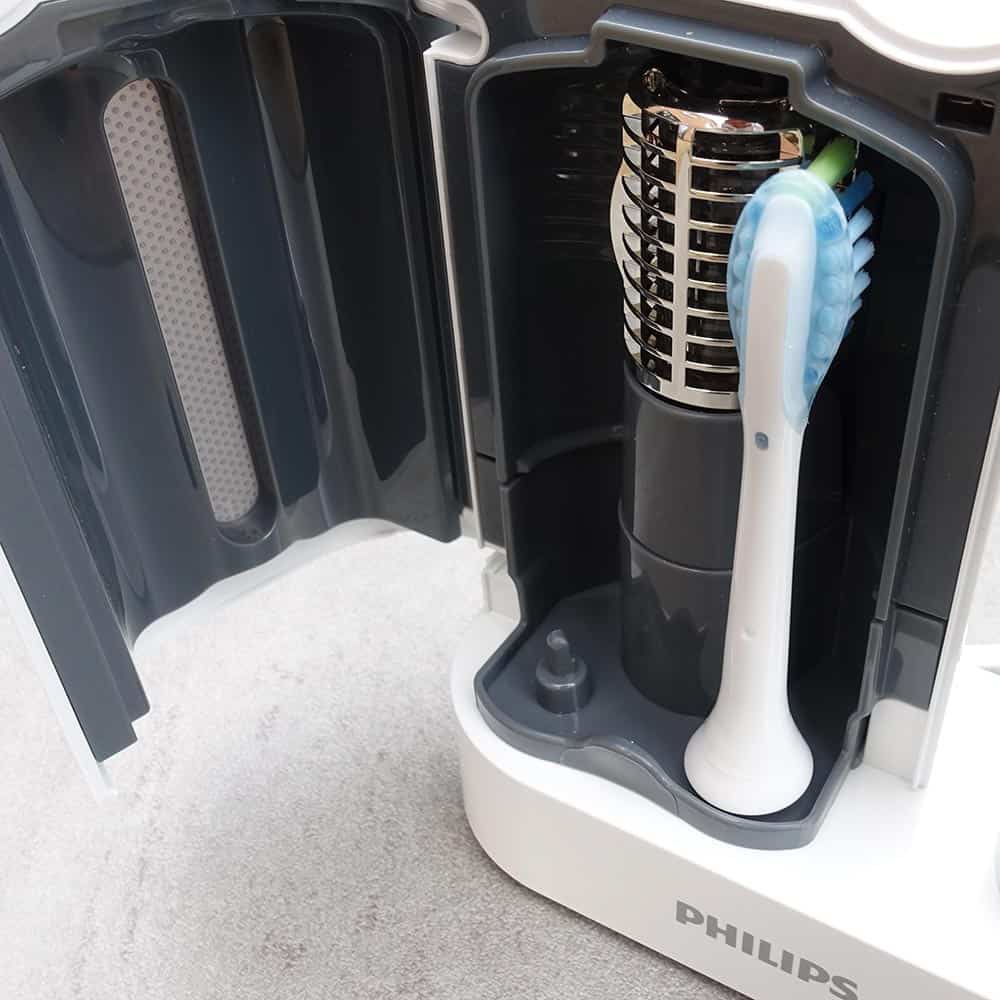
For most, I think the travel case is most useful as it is one of those things we do not need every day, but when travelling it can be a great accessory to keep things together, protect the brush and the head and avoid accidental activation.
Sonicare brushes tend to be supplied less frequently with a series of accessories but the ones that they do, could be considered to be more useful, this is personal opinion of course.
For example, some models have the option of a UV sanitizer. Not only does this provide a home for up to 2 brush heads, it cleans bacteria and germs off the brush head via a light bulb emitting UV rays. To me, this has more perceived value and usefulness than a plastic moulded tray that accommodates 4 brush heads.
The Sonicare travel case that comes with the Sonicare DiamondClean and Prestige range can charge from a USB port on your computer, or connect to a charger like you might use for your smartphone, making it more versatile than the Oral-B equivalent.
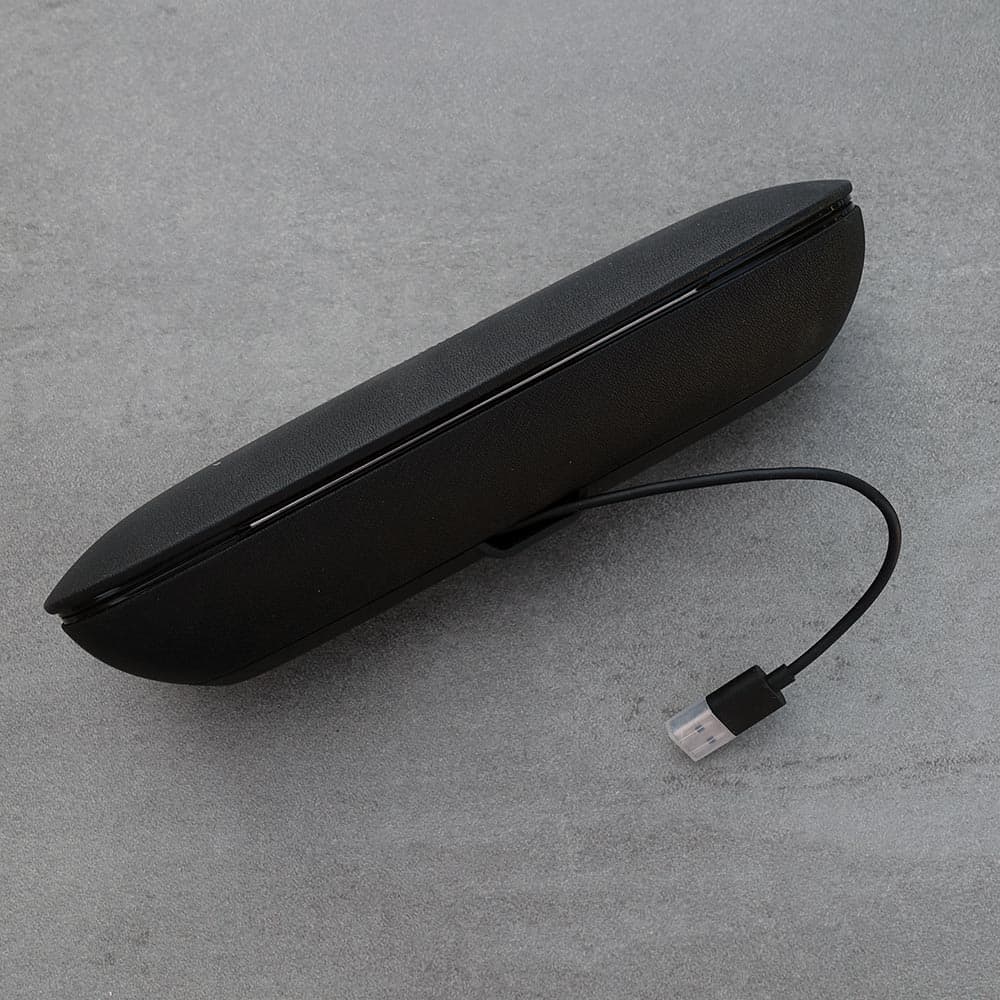
Which has the best battery life?
In my short answers, I said Sonicare.
Oral-B falls a long way short of the mark set by Sonicare.
Typically Sonicare brushes last for up to 3 weeks, some only 2.
Oral-B’s longest lasting brush lasts just 14 days (2 weeks). A significant difference.
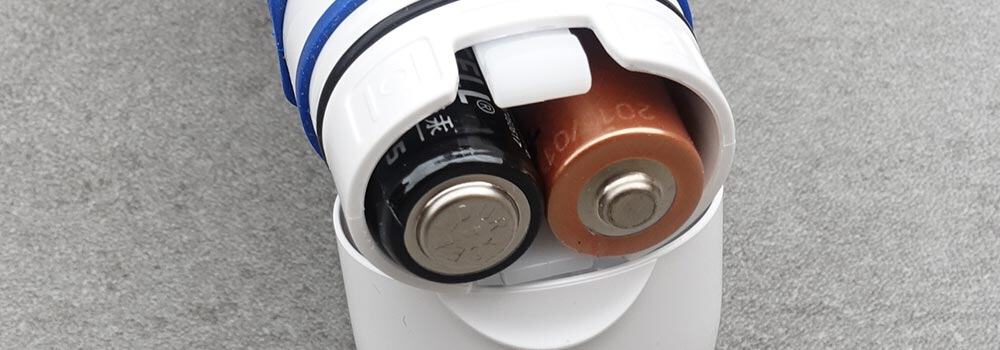
How important this is will depend on your routine. It is safe to leave either brand of brush on charge for a prolonged period of time but for frequent travellers, the extended life of the Sonicare may be preferred.
Although subject to model most in both ranges have battery indicators that give a guide as to when a charge is required.
The reason behind this power difference primarily is the battery technology used. Sonicare have for a long time been using the more desirable lithium-ion batteries whereas Oral-B have used nickel-metal hydride batteries. The latter being an older and cheaper battery that can suffer from a memory effect.
Oral-B have begun, with their current Smart and Genius range to move to lithium-ion, but at 14 days life, this is far from what Sonicare offers.
Some extra life is achieved by Sonicare I believe via the quieter and possibly more efficient motor as well as the automatic power off feature, something Oral-B does not have.
Which is the most innovative?
In my short answers, I said Sonicare.
This is one of the most difficult categories to pick a winner for and both Sonicare and Oral-B are innovative in their own right.
Oral-B was the first to introduce Bluetooth to the toothbrush and their implementation of the pressure sensor is more user friendly.
Oral-B does appear most innovative as its flagship iO has artificial intelligence.
This is very cutting edge and does work. However, Sonicare toothbrushes offer a similar thing, with less prominent marketing and actually, in my opinion, is implemented better from a user perspective.
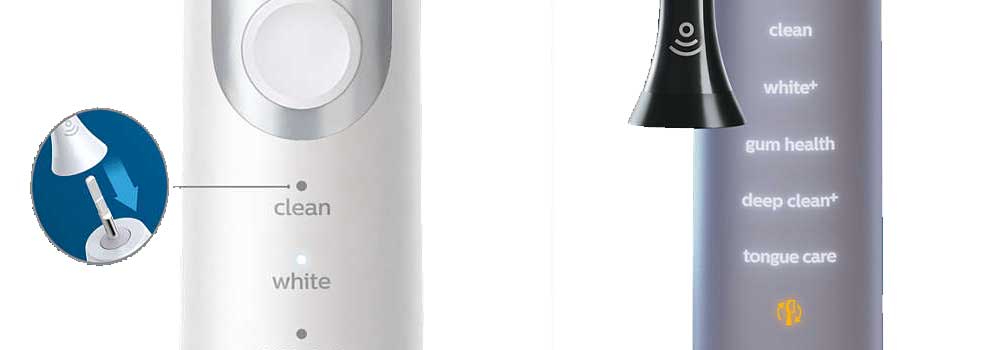
Sonicare have too introduced BrushSync technology which Oral-B have yet to match.
Is the more practical travel cases offered with some Sonicare toothbrushes innovation? You decide.
There are limits to the innovation that can exist within a toothbrush, but Sonicare appears to be shaping change more than Oral-B.
Which is the best quality?
In my short answers, I said Sonicare.
This is much harder to quantify and say for sure.
I have an Oral-B electric toothbrush which is 5 years old and still works, is this a sign of quality?!
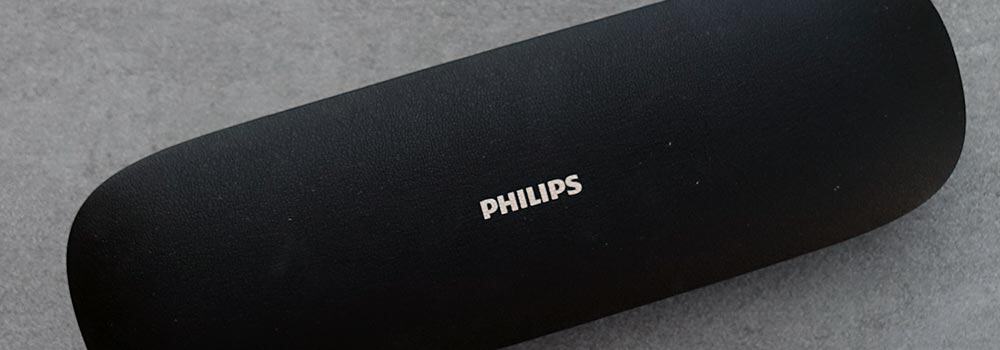
The reason I believe that Sonicare is the best quality is the feel and performance of them in hand. They feel more robust and premium, the plastics look and feel stronger and the overall experience and feeling is that more effort has been put into the product than branding and selling the brush.
Attention to detail comes to mind.
Both brands offer a 2 year warranty to cover manufacturing defects.
My limited experience with customer service and support has within Canada been better from Oral-B than Sonicare.
Which is the cheapest?
In my short answers, I said Oral-B.
The gap is closing here and the difference is not as great as it once was.
Both start around about $40 for an entry level brush.
Oral-B brushes tend to be about 10-20% cheaper for like equivalents as a rough benchmark. Seasons, retailers and models all influence this.
There is a perception of better value for money with Oral-B brushes that is often justified.
However, matters like battery life have a personal value that is not equal for all.
Whilst both brands are subject to discounts and typically can be purchased for 30+% off their RRP with a little shopping around, it is Oral-B brushes that are more heavily discounted on the whole and more actively marketed as being on offer, particularly around Christmas.
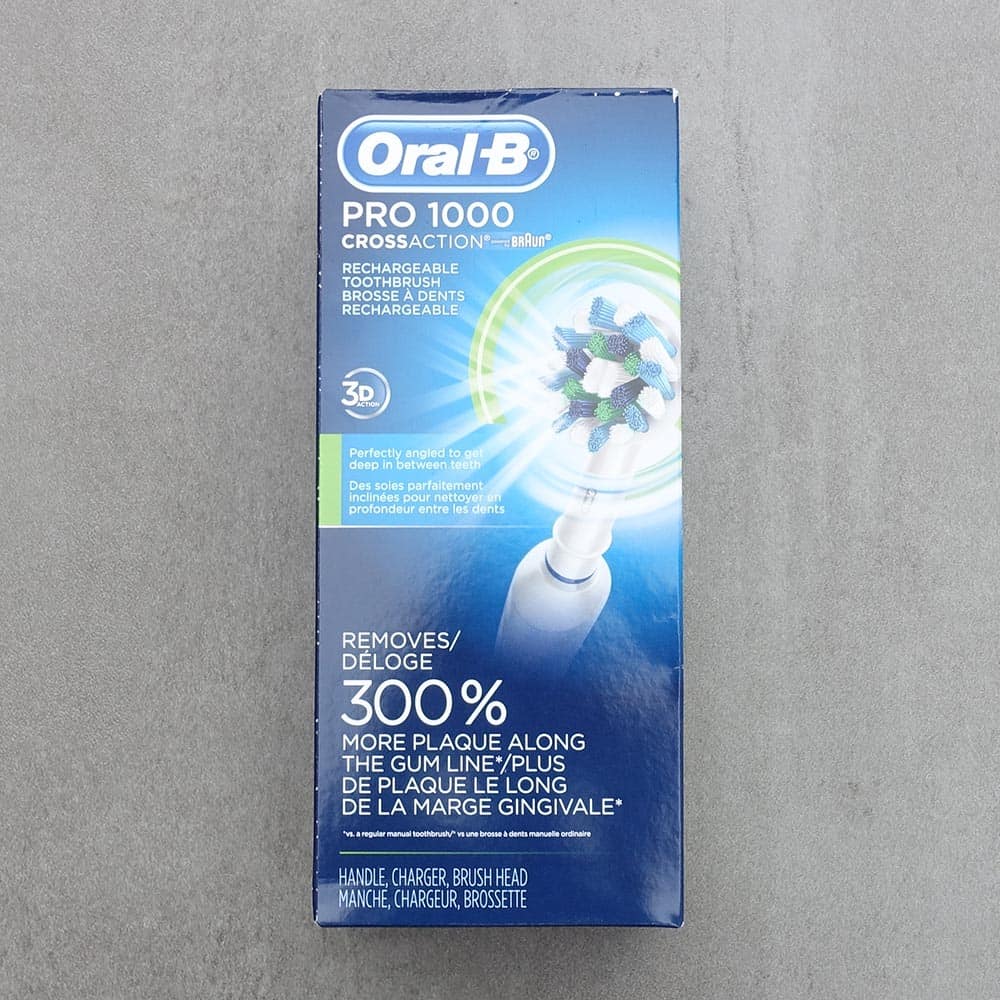
Which is best for families?
In my short answers, I said Oral-B.
Neither Sonicare or Oral-B are perfectly suited to families in my opinion, but out of the two, Oral-B is certainly the better for a couple of reasons.
Often budgets kick in more frequently with a family as does the likelihood of different users having different needs.
On this basis Oral-B brushes offer more cleaning modes at a cheaper price, meaning it is more cost effective for a family.
Many Oral-B models come packaged with a number of different brush heads, and acquiring new ones is often a few dollars cheaper per head for an Oral-B compared to Sonicare. As a rough guide, an Oral-B replacement head may average around $8 compared to the $10 of a Sonicare.
There is often the inclusion of a brush head storage tray which can accommodate up to 4 brush heads, whereas Sonicare models do not tend to come with any storage compartment for brush heads.
One thing to point out is that brushes with Bluetooth can only support one user.
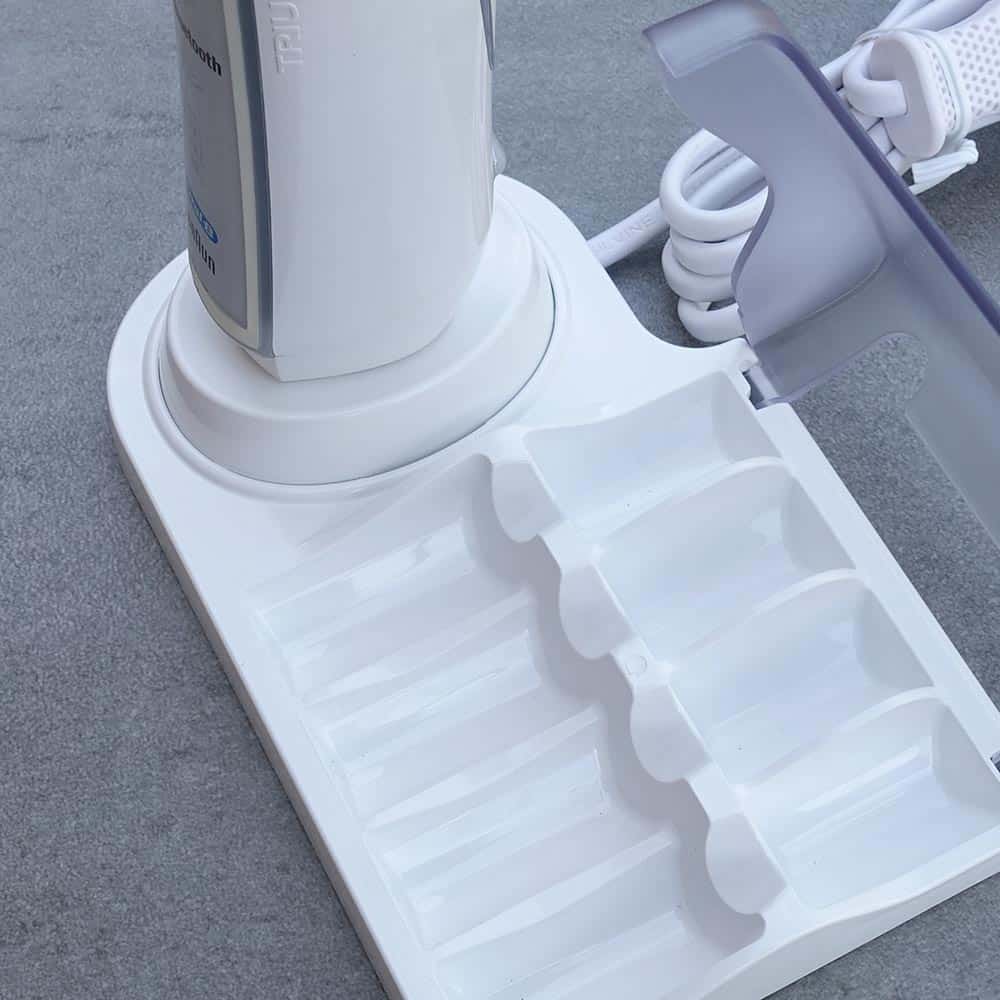
Which is best for travel?
In my short answers, I said Sonicare.
The Philips One by Sonicare is compact, lightweight and ideal for a frequent traveller. But, it is the only really compact option from both brands.
For me, Sonicare wins because of battery life primarily. With up to 3 weeks on most models, that covers most people for more than enough time when travelling. Just take the brush and no charging stand. With Oral-B, even with the most premium brush, you would need to take a charger for a 2 week vacation.
If you invest in the Sonicare DiamondClean or Prestige model you get provided with an excellent quality travel case that allows the brush to be charged in that. Just an extra cable is required and this connects to USB ports, meaning no real need to take a charging adapter.
Other models that do not come supplied with a case offer a charging stand that supports voltages from 110-240 volts whereas the Oral-B models typically only support 110 volts if purchased in the USA. This means it is more difficult to travel with an Oral-B brush as there is less global support for different voltages used around the world.
With either, you will often need an adapter to connect them to different power sockets and that adapter will often regulate the voltage but with Sonicare, you have peace of mind that it will work safely because of the support for the broader voltage range.
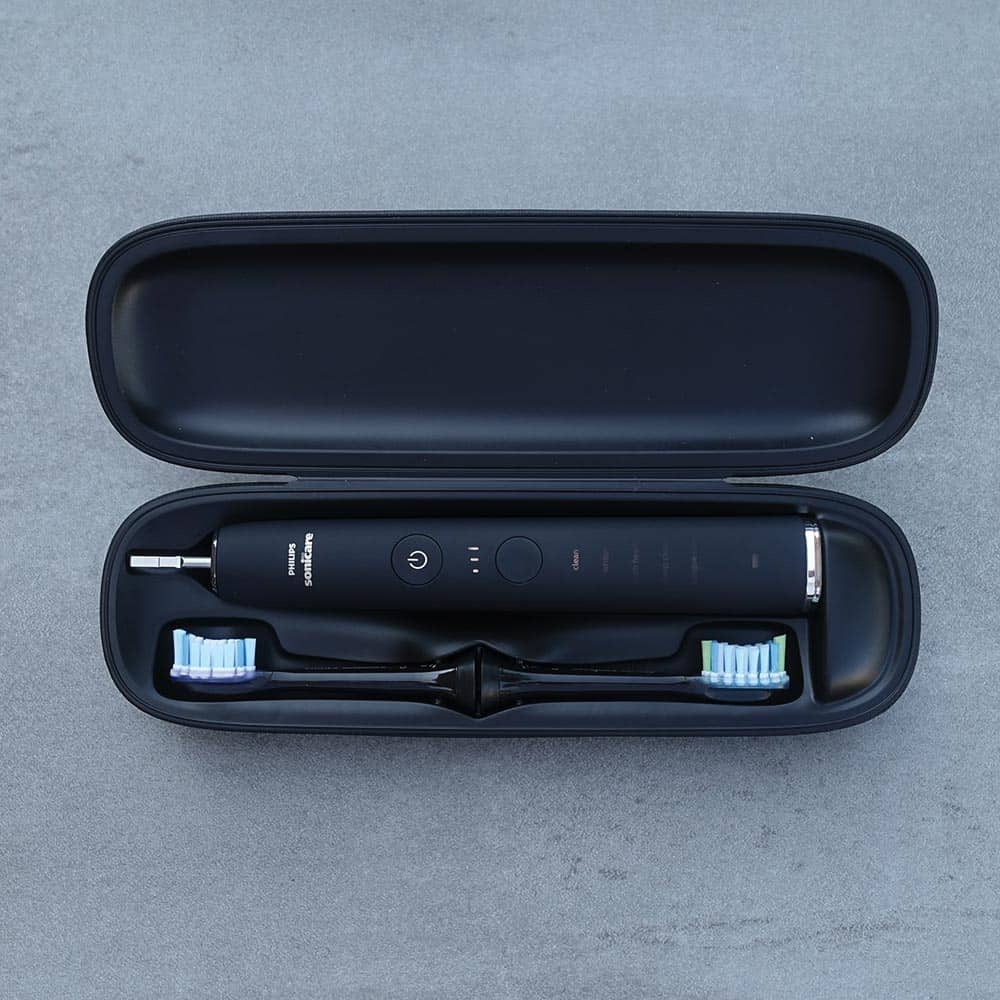
Which has the best warranty?
In my short answers, I said Oral-B.
As standard both brands come with a two year warranty.
Sonicare put a clause in their warranty that the battery is only supported for twelve months (one year) whereas no such clause exists in the Oral-B warranty.
In most instances warranty issues are dealt with on a case by case scenario and it would appear that Sonicare are more likely to replace than repair should something go wrong, but Oral-B does have quite a slick warranty repair process with quick turnaround times.
Communication from Sonicare customer service has in my experience not been as efficient or helpful as Oral-B.
Additional considerations
I believe that the twelve categories on which I have used to judge Sonicare vs Oral-B covers most instances and consideration factors.
However, there will often be differences and other factors considerations to make as these can be personal or model specific.
For example, if you are specifically looking for something with a sensitive cleaning mode and that comes in at less than $60 and has a pressure sensor; despite what might be a personal desire to go for Philips because you trust the brand and like the quality etc, your only option is likely to be an Oral-B model.
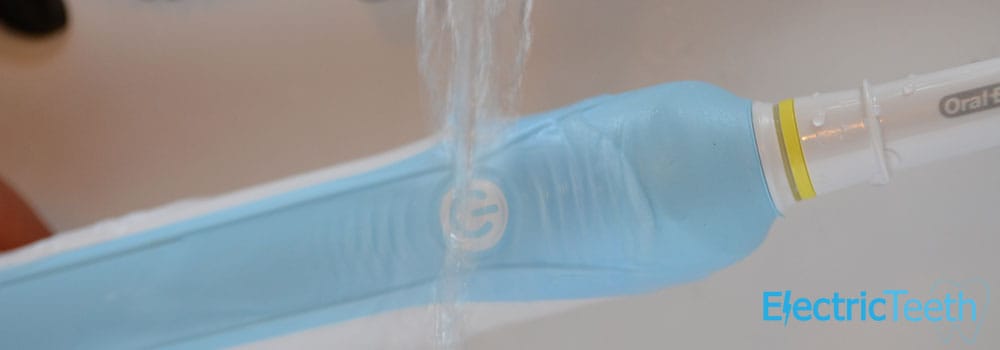
Water Resistance
Whilst both brands typically are designed to resist water and can safely be rinsed under the tap and used in the shower, neither brand would really recommend or advise prolonged exposure to water and certainly advise against immersion/submersion in water.
Timers
Most Oral-B and Sonicare brushes have timers built-in. These come in two forms, a timer that tells you when to change quadrants in the mouth and a timer that tells you the clean is over.
A normal clean lasts for 2 minutes and you should spend 30 seconds cleaning each of the 4 quadrants of the mouth. Most Oral-B and Sonicare brushes have both timers built-in. The 30 second pacer is a pause in the brush head motion that in turn changes the sound emitted from the brush.
The 2 minute timer on Oral-B is a longer/different pause pattern whereas with Sonicare the brush usually automatically turns off. Nether are essential, but both go a long way in making sure you clean your teeth for the right amount of time.
Sonicare vs Oral-B: which brushes in each range are equivalent?
At the time of writing, both Sonicare and Oral-B have about 15 different models each, in their ranges.
That excludes the different color options and those that come packaged with different brush heads in the box.
I am commonly asked, what are the equivalent brush within the Sonicare and Oral-B ranges.
For example, readers may ask, I am looking at the Sonicare 2 series, which is the equivalent from Oral-B.
I am looking at the DiamondClean from Sonicare, which is the best from Oral-B?
There is never an exact like for like, there are always differences between the models.
The following table gives my opinion on which models most closely match between the 2 brands.
| Oral-B | Sonicare |
|---|---|
| Kids 3+/ Kids 6+ | Kids Bluetooth Connected |
| Vitality | Essence+ |
| Pro 500 | Essence+ |
| Pro 1000 | 4100 Series |
| Smart 2000 | ProtectiveClean 4500 |
| Pro 3000 | ProtectiveClean 4500 |
| Pro 6000 | ProtectiveClean 6100 |
| Pro 7000 | FlexCare Platinum Connected |
| Genius Pro 8000 | DiamondClean Smart |
| Genius 9600 | DiamondClean Smart |
| Genius X | DiamondClean Smart |
| iO Series | 9900 Prestige |
Which one to buy?
As I have already intimated, this is not necessarily an easy decision.
I firmly believe that just picking any brush from either brand and using it regularly, with the correct technique, will deliver the greatest benefits. You really can achieve a good clean with Sonicare or Oral-B.
My recommendation for the vast majority of people is to choose between the Oral-B Smart 2000 and the Sonicare 4100 Series.
They both have a 2 minute timer, quad pacer, pressure sensor and rechargeable battery. They offer the most desirable features and benefits of an electric toothbrush without costing a fortune.
As I've mentioned several times in this post the Sonicare is my preferred choice over the Oral-B, but both are great brushes.
|
Our Choice

|
Our Choice

|
|
|---|---|---|
| Electric Teeth Rating |
(5)
|
(5)
|
| Amazon | $89.97 | $59.93 |
| Walmart | - | View price |
I know some simply want the best of the best. If you want that then the models to go for are the Oral-B iO and the Sonicare 9900 Prestige.
In this case the Sonicare is my preferred choice — I explain why in my Oral-B iO vs Sonicare 9900 Prestige comparison — but again it is a very close call.
|
Our Choice

|
Our Choice

|
|
|---|---|---|
| Electric Teeth Rating |
(5)
|
(5)
|
| Amazon | $380.25 | $379.97 |
| Walmart | View price | View price |
Most of us do not need these top of the line models and they certainly do not offer the best value for money, but if that is what you prefer, then go for it.
If you have specific requirements, I do hope that my explanation has at least helped in making your decision and choosing the brand best suited to you.
Both Sonicare and Oral-B make it more difficult than it needs to be to choose a toothbrush. They offer so many models, with such similar features at various price points, which is why we try to keep our own recommendations simple.
If you are still in the process of choosing a brush from one of these brands, you may like to see the following pages:
- Oral-B Comparisons Hub Page
- Oral-B Comparison Chart
- Sonicare Comparisons Hub Page
- Sonicare Comparison Chart
If you are still confused or need more assistance, please do leave a comment below or contact us and we will be happy to help.
Conclusion
Hopefully the various sections of this post have helped you to understand the differences between Oral-B and Sonicare.
You may like to skip back to our verdict at the start, and the quick links section, to check there's nothing you've missed.
Deciding which brand of electric toothbrush is right for you has likely been more confusing and complicated than you originally thought.
For the benefit of your oral health, worry less about the brand of toothbrush and worry more about your brushing technique, brushing time and how often you use the brush.
You will gain the greatest benefit from perfecting these things than you will from picking one brand of brush over another.
Ultimately, both do a great job of cleaning the teeth when used correctly.
There are pros and cons to each and it is possible one brand will appeal to you more than the other.
I do hope that this article has explained why some may favour Oral-B for reasons like budget, whilst Sonicare might be the best choice because of the battery life.
Whatever your decision make sure it is one you are happy with and do let me know what you go for and why.





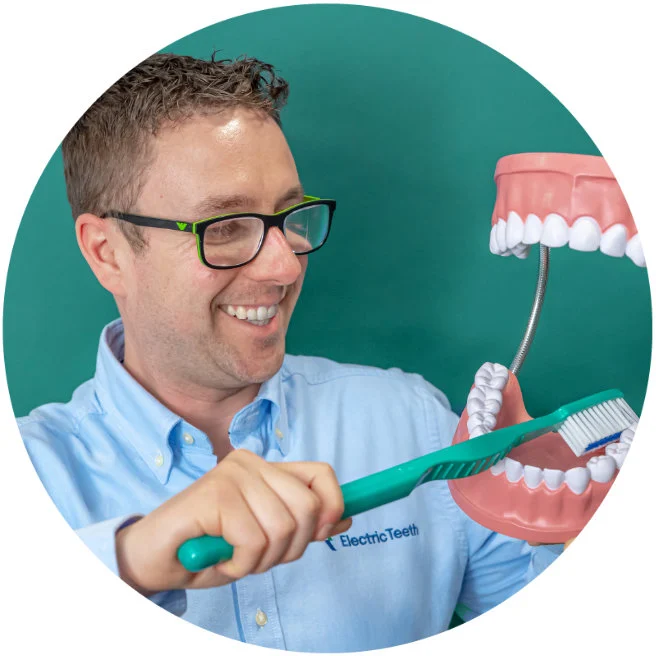
This was a very comprehensive review of both brands. I've used an Oral-B and its antecedent since around 1980. My penultimate one lasted 15 years, until the battery charger stopped working. It was such a nifty little charger, with a light indicator, and about a 3-week charge.
So, I bought another Oral-B. I can't even remember why I promptly returned it and a second one. The third one I think I kept just because I was too embarrassed to march back to the store again.
The new Oral-B was like a jackhammer in my mouth. An evil jackhammer with a mind of its own, almost hard to control, vibrating violently (I'm always nervous it will chip or break my teeth or crowns) and spraying water everywhere: my face, my clothing, my countertop, my mirror. So right away, I went back to my 15-year-old toothbrush, which luckily charged in the new charger (which no longer has a light indicator) and continued to brush happily until my old brush finally bit the dust.
Then I resorted to the wild, loud, violent, spraying new Oral-B. I loathe it and, procrastinating, have tolerated it for far too long. I've been researching and this review/comparison is really helpful.
A slew of customer reviews I read by long-time, once-happy Oral-B users complained that the charge of newer brushes lasts no more than a day or two and the noise is obnoxious. All indicated the quality had gone downhill seriously and are exploring other brands..
I don't want to be an unhappy brusher anymore. It's a necessary part of one's day; it shouldn't be so brutal and annoying. The old Oral-B was such a perfect, purring little gem. And I have a tiny mouth and love Oral-B's round head design.
But it's time to move on and see how Sonicare and I get along. Thanks for the helpful info.
Completely disagree on the quality of Oral B vs Sonicare. I have had 4 Sonicare's. The first one lasted years (years ago), the last 3 have lasted almost exactly 1 year each with misc. problems (won't charge, turn on). They were all the Diamond Clean line. Similar problem with 2 others in my household. So, I need to get yet another replacement and this time I am going with Oral B.
Thanks for sharing your feedback Ron. We do take this on board and continually look to review our content and recommendations based on valuable comments like yours.
Thanks for your reply Jon. The dual brush head has been my preference for several years however, the last few months have been terrible experiences with these brush heads as they kept becoming loose, making it uncomfortable to brush and eventually falling off ( not just the bristles but that entire head section) within 4 to six weeks ( the dual brush head should be changed every 3 months per the instructions). I have been using crest for years and for years I had no problems with the dual brush head. This problem, as I reported to Oral B, is a danger to the consumer.
Thanks for the extra detail. I didn't realize you meant that whole top part of the dual clean brush head, that is concerning.
Hi Jon,
Great comparison/analysis between the two brushes!
One characteristic of the Oral B toothbrush that you did not touch on is the added brush head section to the circular head as a choice option when you purchase the replacements heads. I’ve always preferred this added feature than the stand alone circular head until a few months ago. The extra bristles section began to come loose and kept falling off ( too often right in my mouth as I was brushing) within the first six weeks of use. I did report it to Oral B but they haven’t changed the quality of the product. I purchased Sonicare about a month ago and it cleans and works very efficiently. I’m glad to read that the differences between the two are often minimal ( except of course for the quality of the brush heads).
Regards,
Bertrand
Thanks for the feedback Bertrand.
I think what you are saying, about the added brush head section, is that you like a particular type of brush head Oral-B offer, the Dual-Clean brush head, would I be correct?
It does give a different cleaning dynamic, but it not a brush head style that is actively promoted by Oral-B with the round brush heads being the preference.
I won't deny, it is potentially a difference between them that some may like to know more about.
Odd that the bristles came loose. Are you using a regular toothpaste with the brush head?